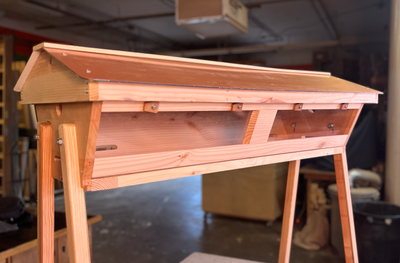Let the Overwintering Series Begin!

When the sun is shining and the days are long, it can be tough to think about winter. For bees though, winter preparations began in spring. As a beekeeper, you will want to begin preparing now. Why? Over 44% of honeybee colonies didn't survive the U.S. winter last year. Some areas saw losses of over 65%. This is why overwintering is such a crucial subject to all beekeepers. Bees work hard to keep warm and ration food stores in cold months. As beekeepers, it's important to help make these processes be as seamless as possible.
So what exactly is overwintering? The term encapsulates multiple systems and processes. Essentially, overwintering is helping bees prepare their hives for the harsh, cold months to come. We're located in the Pacific Northwest, so we'll be using this region as an example, but it will be important to remember that all timelines and practices we provide are completely dependent on your climate. We always encourage connecting with other beekeepers in your area to learn more about overwintering in your specific region.
Let's start with what our bees are up to right now. During mid-to-late summer months, the queen and worker bees scale back brood production. In a way, they're doing math! They will maintain the optimal amount of brood for the overwintering cluster to generate heat that can survive on their available honey stores.

It's important to remember that no bee is created equal. The brood-to-honey-store ratio is variable due to the climate the bee strain (or breed) has adapted to. For example, Italian bees have large brood clusters since Mediterranean climates have short winters. When Italian bees are kept in cold climates, they often eat through their honey stores too quickly and don't survive the winter.
When you conduct your mid or late summer hive inspections, you'll want to make sure your bees are slowing brood production and storing more honey. If they're not, you'll need to consider some of the techniques we go over in this series to aid in their survival.

Another point to start considering is keeping your bees warm throughout the often chilly late summer nights. As a rule, when the temperature drops below 55 degrees (f), do not break the propolis seal on your hive. Your bees created this seal for insulation. Breaking it allows cool drafts into the hive that make it much harder for them to keep warm. This is why you need to be setting your hive up for winter before the temperature drops, ideally in August.
We'll be covering a series of important topics in more depth in the weeks to come. These topics include:
- Late season planting for pollinators
- The dos and don'ts of honey harvesting
- When and if to feed your bees
- Weatherproofing and insulating your hive
In addition to this blog series, we will release corresponding videos for each topic that show these overwintering processes in action. The videos will feature our staff entomologist and Education Coordinator, Rebekah, who is a proud beekeeper and ready to teach you the very best overwintering practices. You can check those out on either our Vimeo or Youtube channel.





